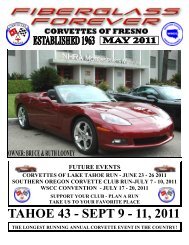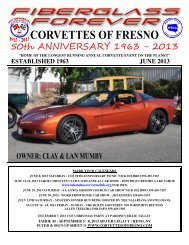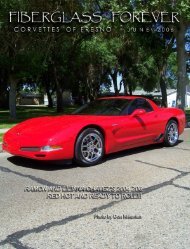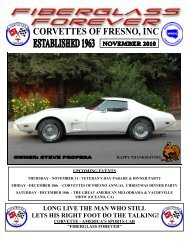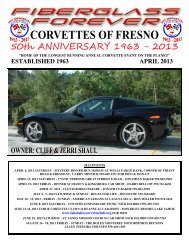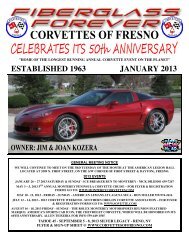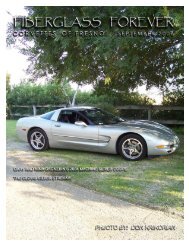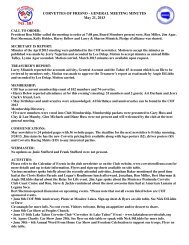Download
Download
Download
Create successful ePaper yourself
Turn your PDF publications into a flip-book with our unique Google optimized e-Paper software.
“Chevrolet has a long history of using racing to improve production cars, and nowhere is that<br />
more evident than with Corvette,” said Jeuchter. “We continually apply technologies and<br />
strategies developed for Corvette Racing directly to the production car. That influence can be<br />
seen in virtually every aspect of the new Corvette Stingray, from the aerodynamic design to the<br />
use of carbon fiber, to the cooling techniques and even in the brake system<br />
The technologically advanced foundation is an all-new aluminum frame structure that is 57<br />
percent stiffer and 99 pounds (45 kg) lighter. The greater torsional rigidity reduces unwanted<br />
noise and improves ride and handling.<br />
Compared to the previous generation, which used continuous hydroformed main frame rails with<br />
a constant 2mm wall thickness, the new Corvette’s frame features main rails composed of five<br />
customized aluminum segments, including aluminum extrusions at each end, a center main rail<br />
section and hollow-cast nodes at the suspension interface points. Each segment is tuned –<br />
varying in thickness from 2mm to 11mm – tailoring the gauge, shape and strength properties to<br />
optimize the requirements for each frame section with minimal weight.<br />
The frame is assembled at an all-new welding shop at the Bowling Green Assembly Plant using<br />
a unique laser welding process in which a computer-controlled beam of high energy joins the<br />
components with exceptional precision and tolerances of about 0.001-inch.<br />
Supporting the frame’s greater strength and lower weight are complementing chassis elements,<br />
including hollow-cast aluminum front and rear cradles that are approximately 25-percent lighter<br />
and 20-percent stiffer than the solid cradles used on the previous structure.<br />
The innovative use of materials includes a standard carbon fiber hood and roof panel, as well as<br />
underbody panels created with carbon-nano composite technology, an advanced blend of<br />
traditional composite material and carbon fiber, which allows lighter underbody panels without a<br />
loss of strength or stiffness. Fenders, doors, rear quarter panels and the rear hatch panel are<br />
made with lighter-density Sheet Molded Compound than the previous generation. Combined,<br />
these materials save approximately 37 pounds (17 kg) versus the previous body structure.<br />
The lightweight elements of the Stingray contribute to the ideal 50/50 weight balance. Combined<br />
with its estimated 450 horsepower (335 kW), the new Corvette delivers a better power-to-weight<br />
ratio than the Porsche 911 Carrera or Audi R8.<br />
Those 450 horses are generated by an all-new LT1 6.2L Small Block V-8 engine, which<br />
produces an estimated 450 lb.-ft. of torque (610 Nm). More importantly, it generates 50 lb.-ft.<br />
more low-end torque than the previous 6.2L engine, matching the 7.0L LS7 engine from the<br />
2013 Corvette Z06 from 1,000 to 4,000 rpm.<br />
The engine’s performance comes from combining advanced technologies like direct injection,<br />
Active Fuel Management and continuously variable valve timing with an advanced combustion<br />
system. More than 10 million hours of computational analysis went into the new Small Block’s<br />
design, including more than 6 million hours alone on the combustion system.<br />
The LT1 is backed by a choice of active exhaust systems that are less restrictive than the<br />
previous generation, due in part to an increase in diameter from 2.5 inches to 2.75 inches. The<br />
standard system offers a 13-percent improvement in airflow and features a pair of butterfly<br />
valves that contribute to greater refinement at cruising speeds when the engine is operating in<br />
fuel-saving V-4 mode.<br />
An available dual-mode active exhaust system offers a 27-percent improvement in airflow. It



